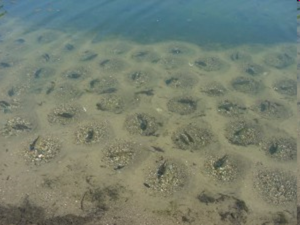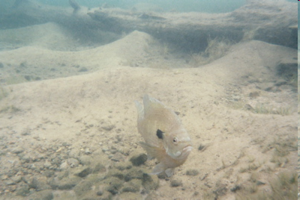Working with the visitors here at the W.K. Kellogg Bird Sanctuary, you hear a lot of interesting questions about the ecosystem we have here. There are of course a lot of questions about the behavior and lives of our waterfowl, some about the trails and plant life, and plenty of unique questions from the kids, but the question that kept grabbing my attention during my internship was, “What’s with the pits in Wintergreen lake?”
The Sanctuary was built around the Wintergreen Lake ecosystem; the lake is a wonderful habitat for the waterfowl conservation efforts that were so highly valued when W.K. Kellogg donated the land to Michigan State University. The lake is a vibrant ecosystem, and visitors can expect to see a diverse assortment of turtles, muskrats and frogs alongside the more commonly spotted swans, geese and ducks. One key aspect of the lake ecosystem however is only truly able to be viewed from above, using the birds-eye view afforded from the Overlook Building. From there, you can look down and see row after row of small pits in the lake bed, packed together like a honeycomb of tiny craters. Several times I’ve had people ask if the pits were natural, or if they had been created by the birds swimming overhead. The real culprits are a lot smaller: the bluegill and pumpkinseed fish that occupy Wintergreen’s shallows.
Bluegill and pumpkinseeds, collectively known as sunfish, are small freshwater fish found across Michigan’s lakes and ponds. And while their nesting behaviors are well-known to fishermen, the more land-locked among us (myself included) often have no idea what it is these tiny fish are doing. Sunfish nest communally, with dozens of male sunfish creating dish-shaped depressions in the sand with their fins. As spawning season approaches, the males become increasingly territorial, defending their nests with so much vigor that the splashes can sometimes be seen from the Overlook. If he’s done a good job defending his territory, when it’s time a female fish will come to his nest and lay up to 60,000 eggs! Each male then guards his thousands of children from a vast rogue’s gallery of predators, including other sunfish, all while fanning the eggs with his fins to keep his babies aerated. By placing their nests in tight colonies, the sunfish greatly increase the survival of the innermost eggs, making sure that even though many eggs are lost, as many as possible pull through and hatch. These new baby sunfish will go on to be a key piece of the Wintergreen ecosystem, providing food for herons and other native predators, keeping aquatic invertebrate levels in check, and providing phosphorus into the environment for photosynthesizers via their waste.
It never stops amazing me the way that these tiny dramas are unfolding in nature all around us at scales we never think to notice. The curiosity of our visitors brought so much to my attention, and I was grateful for the opportunity to answer their most burning questions. Please keep bringing your incredible sense of curiosity to the Sanctuary, and when you to stop by, go to the Overlook and observe the tiny underwater village at the bottom of Wintergreen Lake!!
~~~~~~~~~~~~~~~~~~~~
Ezra Montero was the 2022 W.K. Kellogg Bird Sanctuary visitor experience intern.
~~~~~~~~~~~~~~~~~~~~
https://www3.epa.gov/region1/npdes/schillerstation/pdfs/AR-211.pdf



A legacy of conservation; a commitment to sustainability.
Kellogg Bird Sanctuary12685 East C Avenue
Augusta, MI 49012
Phone: (269) 671-2510 birdsanctuary@kbs.msu.edu